
- Homepage
- Blade Edge
- Blade Material
- 1095 Carbon Steel (7)
- 20cv (6)
- Bohler M390 (5)
- Carbon Steel (732)
- Cpm-20cv (11)
- Cpm-s35vn (9)
- D2 Steel (6)
- Damascus (17)
- Damascus Steel (190)
- Elmax (9)
- Elmax Steel (5)
- Folded Carbon Steel (6)
- Folded Steel (34)
- High Carbon Steel (14)
- M390 (26)
- S35vn (19)
- S90v (7)
- Stainless Steel (462)
- Steel (8)
- Zdp-189 (5)
- Other (789)
- Blade Range
- Blade Type
- 0452cf (4)
- Cleaver (5)
- Clip Point (238)
- Dagger (7)
- Drop Point (334)
- Drop Point, Tanto (4)
- Harpoon (7)
- Hawkbill (17)
- Karambit (20)
- Leaf (13)
- Pen (6)
- Reverse Tanto (6)
- Sheepsfoot (29)
- Spear Point (78)
- Straight Back (8)
- Tanto (66)
- Trailing Point (10)
- Upswept (7)
- Upswept Skinner (3)
- Wharncliffe (74)
- Other (1431)
- Dexterity
- Type
Clay Tempered Hardened Japanese Samurai Katana Folded 15 Times 1095 Carbon Steel
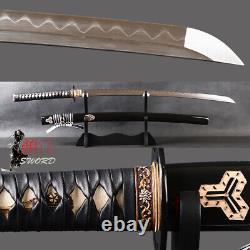
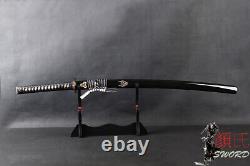
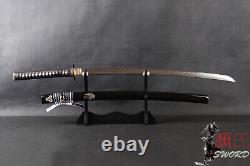
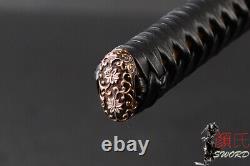
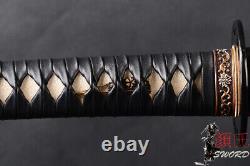
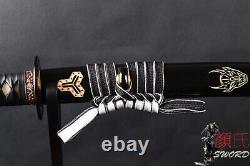
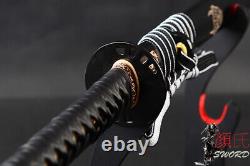
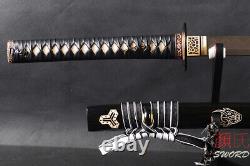
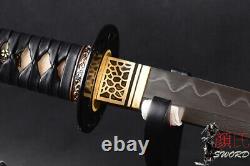
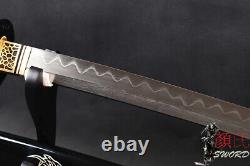
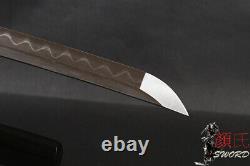
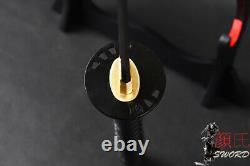


Clay Tempered Hardened Japanese Samurai Katana Folded 15 Times 1095 Carbon Steel. Samurai katana as a weapon is famous for its beautiful shape. They are used as art collection and the symbol of samurai soul. Our sword allows you to make a collection or to send to friends as a present. This katana can be taken apart fully at anytime for maintenance purposes, you can disassemble the sword by taking out the pegs from the handle.
103 cm / 40.6 inch. 70 cm / 27.6 inch.
26 cm / 10.24 inch. 3.2 cm / 1.26. 0.7 cm / 0.28.
Folded by 15 times, 32768 layers, clay hardened. Hard wood core, hineri maki. High grade brass, morning glory.
High grade brass, Chinese fan. High quality brass leopard pattern. Sageo: black & white synthetic silk. Black lacquered wooden scabbard engraved with devil logo. Sword display holder(stand) is not included.
Manual measurement error range 1-2 cm. Before being quenched, a special clay mixture can be applied onto the blade to harden the edge and obtain different hardness on the blade.
The clay mixture was a special recipe and considered a crucial trade secret, guarded protectively by sword making masters. It would contain such things as feathers, powdered bones, grass, etc. And would be applied to the edge of the blade before being quenched. During quenching, a chemical reaction between the clay mixture and the hot steel occurs during the sudden temperature drop and carbon is fed into the blade in.High amounts, creating an extremely tough edge. A clay hardened blade can only be quenched in water, thus increasing the defect rate even more. Another way for clay tempering is to apply clay along the blade but let edge exposed.
Thus, while quenching the blade into water, the uncovered edge will cool down suddenly, but the rest of blade will cool down slowly. Such differential temperature change results in the different hardness of the blade. So the edge is tough enough to cut, where the back of blade is soft /flexible enough to absorb the impact during cutting. Such quenching process usually will leave beautiful wavy tempered line on the blade, as known as "hamon" in Japanese swords term. This means that the carbon steel is folded by 15 times to produce 32768 layers.
The higher quantity of layers provides more unique and mystical hada patterns, which defines and displays the craftsman's experience and knowledge of traditional metallurgy passed down from generation to generation. Only the utmost skilled bladesmiths (Toushyo) and polishers (Togi-shi) can bring out the beauty and life from the Shinsakuto live blade. During the forging process, all of the slags and impurities of the steel are burned off and folded forged to an uncompromised strength with an sharp cutting edge.The final carbon content is 1% and the hardness is an impressive HRC 55°on the Rockwell Scale. This high quality blade can easily cut through tatami straw mats or bamboo for Tameshigiri or Batto-do use. HOW TO DISASSEMBLE A JP SWORD. If you don't like the color or the style of the mountings, you can choose different ones from the options below. Is usually a round (or occasionally squareish) guard at the end of the grip of Japanese swords.
They contribute to the balance of the sword and to the protection of the hand. The tsuba was mostly meant to be used to prevent the hand from sliding onto the blade during thrusts as opposed to protecting from an opponent's blade.Tsuka-ito is the wrapping of the tsuka and sageo?? Is a hanging cord that is passed through the hole in the kurigata??
Of a Japanese sword's saya. Is the ray or shark skin wrapping of the tsuka (handle/hilt). The saya is a wooden scabbard for the blade; traditionally done in lacquered wood. For engraving English words, Chinese characters and Japanese Kanji. For engraving patterns dragon, lion, etc.
Swords can be shaped by a variety of metalworking techniques. The primary techniques are forging and stock removal. Forging uses heat to bring the material to a malleable state.
The material is then hammered to shape, typically using hammer and anvil together with specialized set and fuller tools depending on the particular technique. Stock removal shapes the sword from prepared stock that is larger in all dimensions than the finished sword by filing, grinding and cutting. After the blade has been shaped, the sword would be quenched. We quench our swords in either water or oil. Water quenching produces a tougher edge which can also be hardened further more using clay.
Blades quenched in oil are still considerably hardened and do have superior flexibility compared to a water quenched blade. The more rapidly a blade cools down, the harder it becomes. Thus, when a hot blade enters the water, the water also gains heat and the blade will cool more gradually.Therefore, the first part of the blade that enters the water will be the hardest. Therefore, the technique of quenching was also very important. If a blade has any flaws from forging (air bubbles, ash), it will break immediately during the quenching process.
After quenching, the sword will be quite tough and brittle, with little flexibility. To overcome this, the blade would undergo a tempering process. The blade would be reheated to a certain temperature degree then allowed to cool naturally.
The blade would be slightly less tough afterward but have a greater degree of flexibility - the art would be to perfectly balance the blade for toughness, sharpness and flexibility. Finishing encompasses polishing, decorating, and crafting and assembling the hilt, guard and sheath. The swordsmith would be most concerned with the state of the blade itself and possibly decorating the blade and preparing the guards and pommel.
Other artisans would likely be involved in the work of fashioning the hilt, sheath and other furniture; and in any fine decoration. When the rough blade is completed, the swordsmith turns the blade over to a polisher, whose job it is to refine the shape of a blade and improve its aesthetic value. The polishing process almost always takes longer than even crafting, and a good polish can greatly improve the beauty of a blade, while a bad one can ruin the best of blades.
Early polishers used three types of stone, whereas a modern polisher generally uses seven. On high quality blades, only the back of the blade and the adjacent sides, are polished to a mirror-like surface. To bring out the grain and hamon, the center portion of the blade, and the edge are usually given a matte finish.
Microscopic scratches in the surface vary, depending on hardness. Smaller but more numerous scratches in the harder areas reflect light differently from the deeper, longer scratches in the softer areas. The harder metal appears more matte than the softer, and the manner in which it scatters light is less affected by the direction of the lighting. After the blade is finished it is passed on to a mountings-maker for fashioning the hilt, sheath and other mountings.
International Buyers - Please Note.
